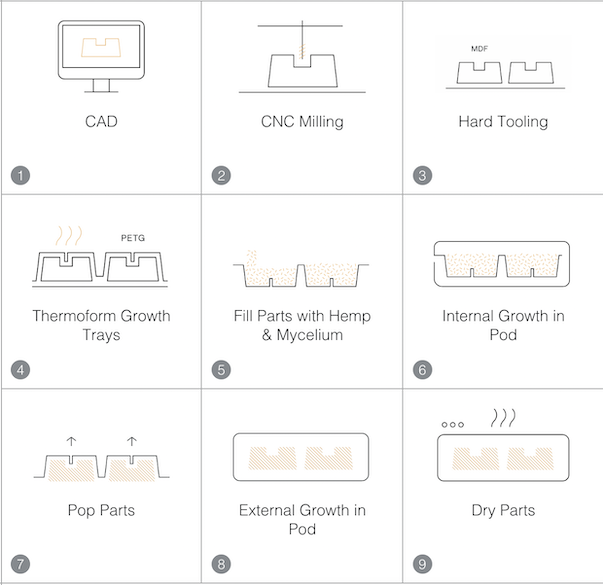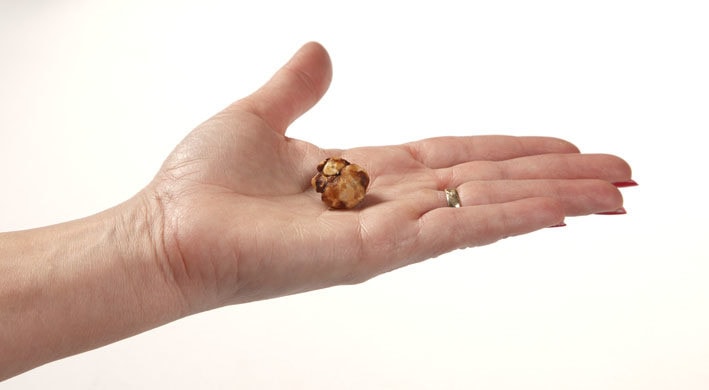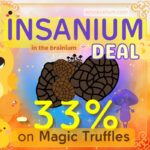A lot of products we use daily are made out of plastic, such as Starbucks coffee cups, straws, and boxes for Chinese takeout. Even shipping boxes are stuffed with “peanuts” to protect fragile items. Plastic is everywhere, and you’d be hard-pressed to avoid it totally.
Alternative to Plastic?
One culprit stands on top of the heap, however. A white, spongy material you know as Styrofoam. Styrofoam is the $20+ billion plastic industry that can never be truly recycled or thrown away. Once made, Styrofoam does not rot… Styrofoam stays in our oceans and landfills for thousands of years!

What if there’s a more natural alternative to plastic? A material made from 100% biodegradable stuff? Are our dear mushrooms coming to the rescue yet again?!
Let’s take a journey back to 2013, when a brilliant discovery has just made it possible for the humble mushroom to be the next plastic
The Anti-Styrofoam
In 2013, Eben Bayer, CEO and co-founder of Ecovative, spoke to The Guardian about how he was able to develop a 100% eco-friendly material that acts like plastic, but is made from mushrooms:
“We’re able to compete with an entrenched billion-dollar plastic industry because we’re not extracting things.
“We’re leveraging the power of biology.”
Here’s why mushrooms are perfect for the job. The webs of wispy roots – called mycelium — eat up waste from crops. Mycelium then converts the crop waste into a “plasticky” material, which is a lot like Styrofoam. All in a span of a few days. The finished product can be molded into any shape you want.
Ecovative calls it Mushroom Packaging.

Mushroom Packaging
Mushroom Packaging acts like real plastic in so many ways. Due to its springy texture, it’s often used in shipping boxes as an alternative “foam pad”. But unlike Styrofoam, Mushroom Packaging is 100% biodegradable. This means you can break ‘em, and toss ‘em into your garden or compost. And because the “shroom plastic” was fed with crop waste, they’ll give nutrients back to the soil.
So how exactly do we turn mushrooms into 100% biodegradable “plastic”? Here’s how it works!
Making “Shroom Plastic”

- Designers make a 3D model of your desired Mushroom Packaging on the computer. These become a real-life, solid “mould” for growth trays – which are reused hundreds of times.
- Growth trays are filled with hemp hurds (natural waste from the hemp plant) and mycelium. This squishy “tray filling” is left to grow for 4 days so it can take shape. As it grows, the mycelium eats the hemp hurds, creating a “natural plastic” of sorts.
- After 4 days, the grown mixture is POPPED OUT of the tray. You can see that the “shroom plastic” has taken the mould’s original shape. Leave it to grow for 2 more days for a velvety skin.
- The fresh “shroom plastic” is dried, which stops the mycelium from growing further. It’s now ready for use as Mushroom Packaging to protect stuff in shipment!
Benefits of Mushroom Packaging
Mushroom Packaging is not just a pretty alternative to Styrofoam. Yes, it’s a nifty packaging material for shipping, but the dried mushroom “plastic” has other useful traits… Such as being:
- Non-toxic. There is no harm in kids or pets that may ingest them on accident, as Mushroom Packaging is not poisonous;
- Naturally fire-resistant. “Shroom plastic” won’t catch fire so easily;
- Home-compostable. You can toss Mushroom Packaging into your compost, where it can break down into mycelium. Lots of nutrients for the soil, too!
- 100% Free of Carcinogens. Mushroom Packaging has no harmful chemicals in it. Unlike Styrofoam, which has a cancer-causing neurotoxin called Benzene;
- A second life for Waste. “Shroom plastic” doesn’t just eat hemp hurds. It eats other wastes, too — such as seed husks and woody biomass, like fallen branches and leaves.
The Dangers of Styrofoam

Careful what you eat from..!!
Because Styrofoam is such a part of modern life, it can be easy to shrug off just how harmful it can be. “It’s not like I’m tossing it anywhere after I eat from it,” one may think. “And it’s not like I’m actually eating it, either!”
Sadly, polystyrene plastics (such as Styrofoam) can get inside the human body, and cause you a whole lotta problems — like cancer.
In 1986, the Environment Protection Agency National Human Adipose Tissue Survey took fat tissue from humans, and found styrene bits in every single sample. That was when the US first realised that plastic can find its way inside us… Even if we’re being careful. If you really think about it, Styrofoam is a poison. Only that it takes years to kill.
Why Mycology Rules
The world of mycology is so vast. Who knew mushrooms can offer a 100% eco-friendly alternative to Styrofoam, at 1/10th of the cost?? Mushroom Packaging is not science fiction, folks… It’s right here in front of ya. Let’s just hope this idea gets some huge investors (ahem, Elon Musk) so it won’t vanish like the water-powered car engine.
When it comes to fungi, we earthlings have barely scratched the surface. For instance, did you know that magic mushrooms and truffles can soon take on Big Pharma? It’s TRUE. Science says so!

Psilocybin — the trippy compound in shrooms and truffles — has been found by scientists to help treat a host of conditions. Such as resistant depression, sports PTSD, end-of-life care, and even the condition of the moment — post-lockdown anxiety.
One thing’s for sure. Shrooms and truffles are definitely here to help you heal… inside and out. Are you ready to start your own shroomy journey??

 INSANIUM Deal
INSANIUM Deal 

 Combo deals >
Combo deals > . It only took 7 days from Australia which is really impressive. I am deeply grateful and excited to experience my truffles now. Looking forward to my journey within xxx
. It only took 7 days from Australia which is really impressive. I am deeply grateful and excited to experience my truffles now. Looking forward to my journey within xxx
 Strength up to 110/100
Strength up to 110/100 
 %
%
 500 gr.
500 gr. 
